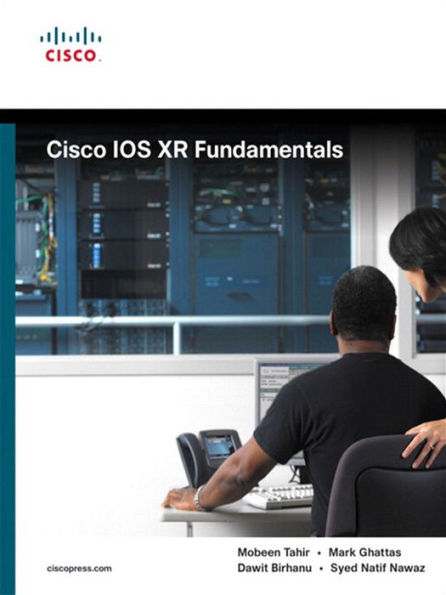Cisco IOS XR Fundamentals is a systematic, authoritative guide to configuring routers with Cisco IOS® XR, the next-generation flagship Cisco® Internet operating system.
In this book, a team of Cisco experts brings together quick, authoritative, and example-rich reference information for all the commands most frequently used to configure and troubleshoot Cisco IOS XR-based routers in both service provider and enterprise environments.
The authors walk you through the details of the Cisco IOS XR architecture and explain commands in the new Cisco IOS XR CLI wherever required. They present concise explanations of service provider requirements and internetwork theory, backed by proven sample configurations for IOS XR services, MPLS, multicast, system management, system security, routing, and interfaces.
Cisco IOS XR Fundamentals is an indispensable resource for designing, implementing, troubleshooting, administering, or selling networks containing Cisco IOS XR–supported routers. This is the only Cisco IOS XR book that:
- Clearly explains how Cisco IOS XR meets the emerging requirements of both current and future networks
- Gives network professionals extensive information for simplifying migration and taking full advantage of Cisco IOS XR’s new power
- Presents detailed, tested configuration examples that network professionals can apply in their own networks
- Walks through using new Cisco IOS XR features and the In-Service Software Upgrade (ISSU) process to minimize downtime and cost
- Use Cisco IOS XR to deliver superior scalability, availability, security, and service flexibility
- Understand the Cisco IOS XR distributed, modular architecture
- Design, implement, and troubleshoot networks containing Cisco IOS XR–supported routers
- Configure Cisco IOS XR routing, including RIP, IS-IS, OSPF, and EIGRP
- Learn BGP implementation details specific to Cisco IOS XR and using RPL to influence policies
- Manage IP addresses and Cisco IOS XR services
- Secure Cisco IOS XR using standard and extended ACLs, prefix lists, and uRPF
- Master all facets of MPLS configuration, including LDP, L3VPN, and TE
- Configure PIM, IGMP, and static RP multicast
- Optimize networks using advanced Cisco IOS XR features, including secure domain routers
- Learn building blocks of Multishelf, and understand configurations and migration techniques
This book is part of the Cisco Press® Fundamentals Series. Books in this series introduce networking professionals to new networking technologies, covering network topologies, sample deployment concepts, protocols, and management techniques.
Cisco IOS XR Fundamentals is a systematic, authoritative guide to configuring routers with Cisco IOS® XR, the next-generation flagship Cisco® Internet operating system.
In this book, a team of Cisco experts brings together quick, authoritative, and example-rich reference information for all the commands most frequently used to configure and troubleshoot Cisco IOS XR-based routers in both service provider and enterprise environments.
The authors walk you through the details of the Cisco IOS XR architecture and explain commands in the new Cisco IOS XR CLI wherever required. They present concise explanations of service provider requirements and internetwork theory, backed by proven sample configurations for IOS XR services, MPLS, multicast, system management, system security, routing, and interfaces.
Cisco IOS XR Fundamentals is an indispensable resource for designing, implementing, troubleshooting, administering, or selling networks containing Cisco IOS XR–supported routers. This is the only Cisco IOS XR book that:
- Clearly explains how Cisco IOS XR meets the emerging requirements of both current and future networks
- Gives network professionals extensive information for simplifying migration and taking full advantage of Cisco IOS XR’s new power
- Presents detailed, tested configuration examples that network professionals can apply in their own networks
- Walks through using new Cisco IOS XR features and the In-Service Software Upgrade (ISSU) process to minimize downtime and cost
- Use Cisco IOS XR to deliver superior scalability, availability, security, and service flexibility
- Understand the Cisco IOS XR distributed, modular architecture
- Design, implement, and troubleshoot networks containing Cisco IOS XR–supported routers
- Configure Cisco IOS XR routing, including RIP, IS-IS, OSPF, and EIGRP
- Learn BGP implementation details specific to Cisco IOS XR and using RPL to influence policies
- Manage IP addresses and Cisco IOS XR services
- Secure Cisco IOS XR using standard and extended ACLs, prefix lists, and uRPF
- Master all facets of MPLS configuration, including LDP, L3VPN, and TE
- Configure PIM, IGMP, and static RP multicast
- Optimize networks using advanced Cisco IOS XR features, including secure domain routers
- Learn building blocks of Multishelf, and understand configurations and migration techniques
This book is part of the Cisco Press® Fundamentals Series. Books in this series introduce networking professionals to new networking technologies, covering network topologies, sample deployment concepts, protocols, and management techniques.

Cisco IOS XR Fundamentals
512
Cisco IOS XR Fundamentals
512
Product Details
| ISBN-13: | 9781587140075 |
|---|---|
| Publisher: | Pearson Education |
| Publication date: | 06/01/2009 |
| Series: | Fundamentals |
| Sold by: | Barnes & Noble |
| Format: | eBook |
| Pages: | 512 |
| File size: | 27 MB |
| Note: | This product may take a few minutes to download. |
| Age Range: | 18 Years |
